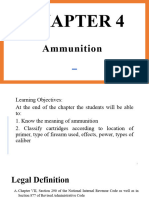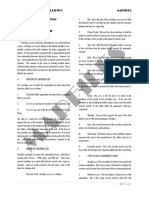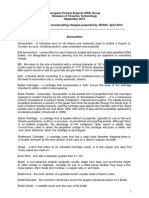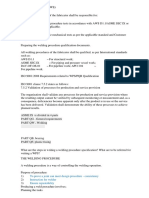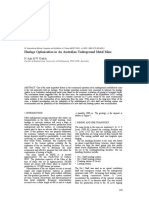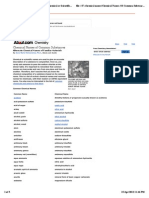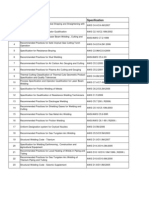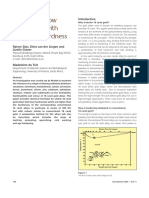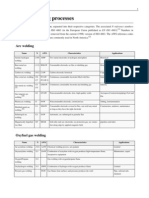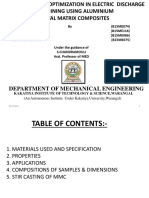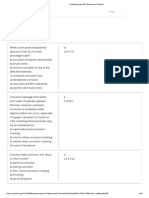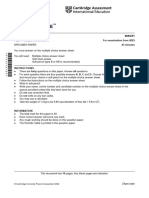CHAPTER IV
Ammunition
Legal Definition
A. Chapter VII, Section 290 of the National Internal Revenue Code as well as in Section 877 of
Revised Administrative Code
➢ It refers to a loaded shell for rifles, muskets, carbines, shotguns, revolvers, and pistols
from which a ball, bullet, shot, shell or other missiles may be fired by means of
gunpowder or other explosives.
B. Republic Act No. 10591
➢ It refers to a complete unfixed unit consisting of a bullet, gunpowder, cartridge case and
primer or loaded shell for use in any firearm.
Technical Definition
➢ It refers to a group of cartridges or to a single unit cartridge - meaning a complete
unfired unit consisting of a bullet, cartridge case, gunpowder and primer. The term may
also refer to a "single round".
➢ Cartridge is a complete round of ammunition for a firearm. The term cartridge and
ammunition can be used interchangeably.
1 | Page
�Origin
The cartridge evolved about the turn of the 16th century. In 1635, the first cartridge was
invented by King Gustavus Adolphus of Sweden. He was credited with this invention. These
were simple packages, which he furnished to his troops during the 30 years of war. The package
was torn, and the content was poured down inside the barrel. Most shooters during those days
had to carry two powder horns, the first is for the powder to be poured in the barrel, and the
second is for the fine grains powder for priming charge. The invention of paper cartridge
eliminated the package of the use of the horn in carrying the powder mixture in bottles or
tubes.
The term cartridge evolved about the turn of the 16th century. The earliest small arms
ammunition or cartridge consisted of a pre-measured charge of powder wrapped in paper. The
term cartridge is derived from the word "charta", the Latin word for paper. Later on, it came
through the French word "cartouche", meaning a roll of paper, which indicates that the original
cartridges were not the brass gliding metal tipped units which we are familiar with today.
The paper cartridge remained standard, for muzzle loading firearms though the middle of the
19th century. The paper cartridge was designed for the combustible cartridge. It was employed
in muzzle-loading firearms, revolving chamber firearms, and in several breech-loading firearms.
The casing and enclosing the gunpowder was made from nitrated paper, collodion, cloth, animal
intestine or some other materials which would not leave a residue in the chamber of the gun
barrel after firing.
2 | Page
�Classification of Cartridges
1. According to Location of Primer
A. Needle-fire cartridge - the primer is placed in the base of the bullet. A long sharp firing
pin is pierced the paper or foil case to reach the primer.
B. Tit-fire cartridge - a copper case nipple was containing the protruding cup,
through which a hole rears the breech block, to the struck and detonated
by the falling hammer.
C. Tail-fire cartridge - the opening of the rifle for loading is compressed by spring, once the
rifle has been loaded and the breech is closed, operation of the trigger to crush against
the underside of the block and detonate a flat percussion tail from the rear of the
cartridge.
D. Pin-fire Cartridge - the first cartridge of a self-exploding type developed by Monsieur Le
Le Facheux of Paris, around 1836. The primer was placed on the sidewall of a copper
case and a brass pin was installed in the opposite side of the case, the intended pin
rested on the primer then the hammer falls on the side of the case, driving the pin into
the primer.
E. Rim-fire Cartridge - developed by Louis Nicolas Auguste Flobert of France, around 1845,
the priming mixture is contained or located in the cavity inside and around the rim of the
cartridge which is a very sensitive area. This cartridge is usually applied to caliber .22
firearms.
F. Ring-fire Cartridge - it is a type of cartridge used on the sabotage case. This is a special
type of cartridge wherein the priming mixture is placed in a circular hollow ring about
1/3 of the base of the cartridge.
3 | Page
� G. Volcanic Cartridge - a system made by Robin and Laurence around 1854. The cartridge
was a mini ball with a base cavity filled with propellant. A paper disc holding a fulminate
pellet is closed at the back of the base, this type of cartridge issimilar to needle-fire but
the firing pin can easily damage.
H. Center-fire Cartridge - in 1858, the Moors cartridge marked the development of this
cartridge. The primer cap is forced into the middle portion of the head of the cartridge
case.
2. According to the type of firearm used
A. Revolver Cartridge - it has a rimmed base, which allows the cylinder where the chamber
is located to clamp its rim.
B. Pistol Cartridge - extracting grooves are designed to allow easier packaging of the
rounds in the magazine.
C. Assault Rifle Cartridge - longer than a hand weapon and generally bottle necked for
larger powder capacity and increased powder.
D. Shotgun Cartridge - the case is generally made up of plastic or paper designed to fire
several projectiles spreading out to create a come of fire.
E. Caseless Cartridge - the powder is the casing itself, of the projectiles. It requires
varnishing to protect it from moisture and moderate shocks. There are few residues left
after the gunpowder had exploded. The cross section is generally fragile to cause
fragmentation.
3. According to its Effects
A. Penetrators - pierce targets using a single bullet
B. High explosives - burst before hitting their target, fragmenting into thousands of
penetrating pieces or becoming a high-speed jet of molten metal.
4 | Page
� C. Carrier projectiles - break open near the target to deliver leaflets, radar-deceiving
materials, or submunitions (small ammunition).
4. According to Power
A. Low-power Cartridge - with a muzzle velocity of less than 1,850 feet per second.
B. High-power Cartridge - with a muzzle velocity of 1,900 fps to 2,500 feet per second.
C. High-intensity Cartridge - with a muzzle velocity of more than 2,500 feet per second.
5. According to the type of Caliber
The caliber of a gun is the diameter of its bore, measure in a fraction of an inch between
two opposite lands for the barrel with even lands. The caliber of a firearm designated only as an
approximation of the bore diameter and is usually closer to the groove diameter. The different
systems of measuring the caliber of a firearm are Metric or European (millimeter) and English or
American (inches) systems of measurement.
Shotgun Shell
It is the cartridge for the shotgun. It is also called a "shell", and its body may be made up of
metal or plastic or paper with a metal head. The length of a shot shell is normally given in
inches and is based on the length of the spent hull.
5 | Page
�Parts of Shotgun Shell
A. Shot cup - it is a plastic cup that holds shot in pattern as it leaves from the muzzle of the
firearm.
B. Tube or case - prior to 1960, paper tubes were used, with mouth closed by rolled crimps
or with plastic body or hull with mouth closed by die crimp, eliminating the need for the
overshot wad.
C. Primer - it is the very sensitive part of the cartridge located in the bottom portion of the
case which ignites the powder charge.
D. Propellant - a chemical compound used in firearms that burns upon ignition. The gases
produced by this rapid combustion propel the pellet down the bore of the firearm. E.
Crimp -a portion of the cartridge that is bent inward to hold the shots in place.
F. Wads - it helps to contain the shot, seal off the shot payload from the ignition gases to
prevent deformation and protect the barrel from lead building up. The four types of wads
are base wad, under powder, over powder and filler. G. Shot/pellet - small spherical
projectiles for the shotgun.
6 | Page
�Kinds of Shot/Pellet
1. Buckshot (BS) - consist of a number of lead balls that spread out as they travel.
These pellets are not very effective (in 00 buckshot, each one is .33 inch in diameter),
but collectively they result in large and destructive wounds. At a longer distance,
however the shot spreads and fewer pellets hit the target.
2. Birdshot - it is the smallest type of shotgun pellets. It is typically used by hunters
who to shoot birds or other flying wildlife. who want
3. Slug (SL) - instead of a group of lead balls, the shell contains a single huge bullet
with angled grooves cut into its side to spin it, as it travels down the smooth bore of a
shotgun. The penetration of aslug is better than shot, but the wound channel is not as
wide as the shot.
4. Tungsten-Iron shot - it is formed either powdered tungsten and powdered iron,
they are blended together and pressed into a pellet, then sintered or bonded together
by the heating process. The shot is coated with a rust inhibitor and it is harder than both
lead and steel.
5. Flechette Shot (FS) - a cluster of sturdy steel needles, replaced the shot of the
standard shotgun shell. These flechettes have tiny fins at their base to stabilize them in
flight. Air resistance is greatly improved over shot than in armor piercing capability.
6. Armor-piercing Bullet (APB) - the discarding sabot slug processes an
aerodynamic shape that keeps it stable flight even though it does not spin. It is smaller in
diameter than a standard slug and surrounded within the shell by a tow-piece plastic
7 | Page
� sabot. After exiting the barrel, the sabot splits in half and falls away because of air
resistance.
7. Steel Shot - it is made by cutting soft steel wire into short lengths, which are
formed into the shot. The shot is then annealed and coated with a rust inhibitor. Wads
for steel shot ammunition, are molded from high density polyethylene. It has thick
sidewalls to prevent the pellets from contracting the shotgun bore surface. High velocity
steel loads have a cushion to reduce recoil.
8. Tungsten-Iron and Steel - this shell has a layer of steel over a layer of Tungsten-
Iron. It gives a dense combined pattern at longer ranges. It can be used in any shotgun
recommended for steel shot.
CHAPTER V
Bullets
Definition
It is a metallic or nonmetallic, cylindrical projectile propelled from a firearm by means of
an expansive force of gases coming from burning gunpowder.
The term may also include projectiles propelled from shotguns, although strictly
speaking, these projectiles designed for shotgun are called "shots" or "pellet".
Origin
The term bullet originated from the French word "boulette", which means "small ball".
The projectile of most small arms ammunition primarily means a projectile from a rifled arm
which is cylindrical or cylindro-conoidal in shape as opposed to round projectiles which are
commonly called either a ball or shot.
8 | Page
�Classification of Bullets
1. According to Use
A. Ball bullets - those have soft cores inside a jacket and are used against personnel only.
B. Armor piercing bullet - those that have steel cores and are fired against vehicles and
other armored targets in general.
C. Tracer bullet - those that contain compound at its base which is set on fire when the
bullet is projected. The flash of smoke from this burning permits the flight of the bullet
to be seen, especially at night time. This type of bullet is primarily used for target
acquisition.
D. Incendiary bullet - those that contain mixture, such as phosphorous or other material,
that can be set on fire by the impact. They are used against the targets that will readily
burn such as aircrafts or gasoline depots.
E. Explosive (fragmentary) bullet - those types of bullets that contain a highly charged
explosive. Because of their small size, it is difficult to make a fuse that will work reliably
in small arms ammunitions.
2. According to Mechanical Construction
A. Lead bullets - those which are made of lead or alloys of this metallic lead, tin and
antimony which are slightly harder than pure lead.
B. Jacketed bullets - those with a core of lead covered with a jacket of a harder material
such as: gilding metal, a copper alloy of approximately 90% copper and 10% zinc.
C. Synthetic bullets - those made of plastic/plasticize and other compositions or those
made of sand polymer mixed. Such bullets were designed for special purposes.
9 | Page
�3. Bullet designed for Handguns
A. Full metal jacket - lead core is enclosed by a strong metal jacket on this non-expanding,
deep-penetrating, general purpose bullet that provides smooth, reliable feeding in all
types of semi-automatic handguns.
B. Jacketed hollow point - the exposed lead at the tip of the jacketed hollow point, rapidly
initiates uniform controlled expansion that progresses to the depth of the hollow point
cavity. It has excellent accuracy and bullet integrity.
C. Semi-jacketed hollow point - it has more exposed lead at the tips, which expand less
than a jacketed hollow point bullet.
D. Full metal cone - the lead core of this bullet is enclosed in a light copper jacket, which
has a cone shape and a flat point. The result is less expansion than the JHP bullet, but
more than an FMJ, and deeper penetration than SP bullet.
10 | Page
� E. Lead wadcutter - the full wadcutter profile of this solid lead cuts clean signature in paper
targets for precise scoring.
F. Lead semi-wadcutter - solid lead bullet with the semi-pointed nose. Formed by a
swaging process with a sharp shoulder for clean hole punching in paper targets. It is a
good choice for general purpose shooting.
G. Soft point - Exposed lead soft point initiates reliable expansion, provides deeper
penetration than hollow point bullets. Precisely engineered copper jacket and the
swaged lead core provide the necessary concentricity and balance required for top-level
accuracy.
H. Lead round nose - solid lead bullet with rounded ogive for downrange accuracy.
4. Bullet designed for Rifles
A. Full metal jacket - the lead core of this bullet is enclosed in a heavy copper jacket, which
results in little or no expansion and deep penetration.
B. Full metal jacket boat tail - same with the full metal jacket with boat tail heel to further
reduce drag to improve downrange velocity. c. Hollow point boat tail - extremely
accurate hollow point bullet with a pointed aerodynamic design. Boat tail heel to further
reduce drag to improve downrange velocity. Precision balance and exceptional
concentricity greatly increase bullet stability to assure superb accuracy.
C. Soft point - Exposed lead tip on this bullet and broader point diameter provide rapid,
controlled expansion at somewhat lower velocities. Broad wound channel results from
expansion up to 200% of the original bullet diameter.
11 | Page
�Different Types of Bullets
1. Hard ball - a copper sheath, the jacket, over a core of lead. It is the standard projectile
type, expanding very little, but giving good penetration.
2. Depleted Uranium - it is ideal for use in armor penetrators because it has an exceptional
performance against armored targets.
3. Semi-wadcutter - a bullet with a flat nose in front of a sharp wad-cutter style shoulder.
This type of bullet, when the shoulder is too sharp will have a clear-cut hole on the
target.
4. Silver tip - Winchester trademarks for certain bullet designs. The jacket will disintegrate
into small pieces that will precisely cause hemorrhage.
5. Fragmentation or explosive bullet - split to fragment when hitting soft tissues, creating
big wounds but tends to retain its form when penetrating armor.
6. Spitzer - a type of bullet having a sharply pointed nose. This type of bullet when this type
of bullet hits a hard object like bones inside the body, it changes its bullet track hence,
and the tendency is that, the bullet travels sideways which will create a wider size of the
exit wound.
7. Dumdum bullet - outlawed for use in war, any bullet with the core exposed.
8. Soft point or mushroom bullet - expands as it strikes an object and produces much more
serious shock and has correspondingly greater stopping power.
9. Hollow point bullet - bullet with a cavity in the nose designed to increase the expansion
when it hits the target.
10. Steel jacketed bullet - composed of a soft steel jacket, often clad or plated with gliding
metal to prevent rusting and reduce frictional resistance in the bore.
11. X-bullet - is a solid copper projectile, heat treated for extra toughness with no separate
jacket and no lead core. It was designed by Randy Brooks.
12. Pointed bullet - more effective than round ball because there are fewer surfaces
presented to the air and thus the speed of the bullet is less retarded so quickly.
13. Boat tail - a bullet with a base tapering to the smaller diameter.
12 | Page
� 14. Gas check - a small metal cup fitted to the base of a lead bullet, to protect it from the
hot gases created by the burning gunpowder.
15. Glaser safety slug - is high performance ammunition that gives superior penetration in
solid targets, while delivering maximum stopping power, with minimum danger from
over penetration and ricochet.
13 | Page
�Parts of a Bullet
1. Base - the portion of the bullet that receives the thrust and heat from the burning
gunpowder.
14 | Page
� 2. Bearing surface - the area of the bullet that contacts the barrel riffling. A tight fit is
required to prevent chamber pressure leaks and to provide good contact with the rifling
grooves.
3. Cannelure/crimping - the serrated groove or depression rolled around the body of the
bullet usually used in bottle neck cartridge.
4. Core - the bulk of the mass in the bullet.
5. Head height - length of the bullet from the shoulder to the tip.
6. Heel - the location of the bullet where the heel ends and the bearing surface begins.
7. Jacket - the material that covers some or the entire core.
8. Meplat - the diameter of the flat or blunt end of the nose of a bullet.
9. Ogive - the radius of the curve between the bearing surface and the point usually stated
with respect to the caliber.
10. Point - the most forward point of the ogive.
11. Shoulder - the place on the bullet where the parallel sides' end and the ogive begins.
15 | Page
�16 | Page
